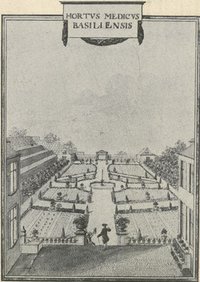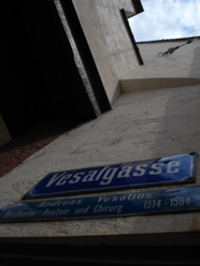From Hippocrates to Paracelsus: the early days of the Faculty of Medicine
The Faculty of Medicine has existed since the University of Basel was founded, initially only with one full professor. The sixteenth century marked a significant period of innovation with figures such as Paracelsus and Andreas Vesalius, who sought to anchor theoretical knowledge in practical experience.
In the university’s early years, the study of medicine in Basel was deeply rooted in medieval-scholastic traditions. As at other European universities, the curriculum was primarily focused on the philological study of canonical texts. Students engaged with the classical texts of Galen and Hippocrates in their original languages, while surgery was left to barbers, stone cutters, and cataract surgeons not considered part of the medical elite.
Philippus Theophrastus Aureolus Bombastus von Hohenheim, better known as Paracelsus, was particularly vocal about the need to extend medical studies beyond the confines of the library. His appointment as the city physician in 1527 allowed him to teach at the university, albeit without the faculty’s consent; they saw Paracelsus’s approaches as a threat to their traditional methods. Paracelsus’s open disdain for the faculty’s learned doctors led to his expulsion from both his position and the city within a year. His advocacy for a medical education that transcended the critical analysis of texts while also aspiring to be more than the practical application of natural science nevertheless remained influential.
Andreas Vesalius emerged as another pivotal figure several years later, arriving in Basel in 1543 to publish his seminal work on anatomy, De humani corporis fabrica (On the fabric of the human body), with Johannes Oporin; he also conducted a famous series of anatomy lectures with direct demonstrations on human cadavers. Though his time in Basel was short, like that of Paracelsus, he left a lasting impact that helped Basel’s medical studies flourish in the late sixteenth century. Felix Platter continued the tradition of public dissections, and an anatomical theater was established at the Lower College.
Enrollments numbered some thirty students a year, and soon a practical professorship for anatomy and botany was established alongside the theoretical chair. This integration of theory and practice remained definitive for the life of the faculty throughout the following centuries.
Reorganization of the faculty in the University Act of 1818
Like the other faculties, the Faculty of Medicine experienced a notable decline in enrollments at the beginning of the nineteenth century. In 1818, the year of the new University Act, it was reported that only one student was enrolled to study medicine. The increasing specialization of the field is evident in its newly established professorships. In 1835, spurred by the revision of the University Act following the separation of Basel-City and Basel-Countryside, four professorships were established: anatomy, physiology and pathology, surgery, and finally botany. Initially, the salaries of professors at the Faculty of Medicine were comparatively low: professors at the Faculty of Law received 1,600 francs, while those at the Faculty of Medicine received “only” 800. Forty years later, however, this amount had already increased to 3,000-4,000 francs. While these disciplines were initially linked in various configurations, they increasingly became independent in the second half of the nineteenth century and were supplemented by further new professorships (for the Medical Clinic in 1855, physiology in 1873, psychiatry in 1875, obstetrics and gynecology in 1887, and hygiene in 1892).
This period also saw the founding of important clinics. The Eye Clinic was the first in 1867, followed by the Children’s Clinic in 1868, the Polyclinic at the hospital, the Psychiatric Clinic in 1875, and the Ear Clinic (operated privately at first) in 1879.
At the turn of the twentieth century, the growth of the Faculty of Medicine was further evident in spatial terms, as the medical departments gradually moved out of the Lower College. Among the first subjects to leave Cathedral Hill for St. Peter’s Square were pathology (in 1880) and anatomy (in 1885), whose presence had often led to complaints about “foul odors.” Anatomy moved together with physiology into the Vesalianum, a name that was intended to remind people of the long tradition of these disciplines in Basel. The unexpectedly high need for space due to increasing student numbers and more complex practical requirements became evident when the Anatomical Institute moved into its own new building in the St. Johann district in 1921, nearly forty-five years later, where the increased demands could be met. It featured, on the ground floor, a study room with anatomical specimens and a mortuary. The dissection room and a lecture hall with 180 seats were on the second floor, with collections on the third. Another forty years later, plans began for a further expansion, which was not realized until the 1990s.
In addition to the increasing need for space, another important development of the twentieth century began at this time: collaborations between professors (such as those in physiology or pharmacology) and the pharmaceutical industry, with the aim of furthering research; conducting clinical and animal experimental tests; hiring graduates; and fostering other professional connections (i.e., research heads and laboratory managers in the industry served at the university as extraordinary professors or as Privatdozenten – faculty with the obligation to teach having completed a habilitation, but without a professorial appointment). Here, too, cooperation between industry and the state in the construction and equipment of institute buildings and in the financing of salary supplements for professors and assistants became the norm during the twentieth century.




